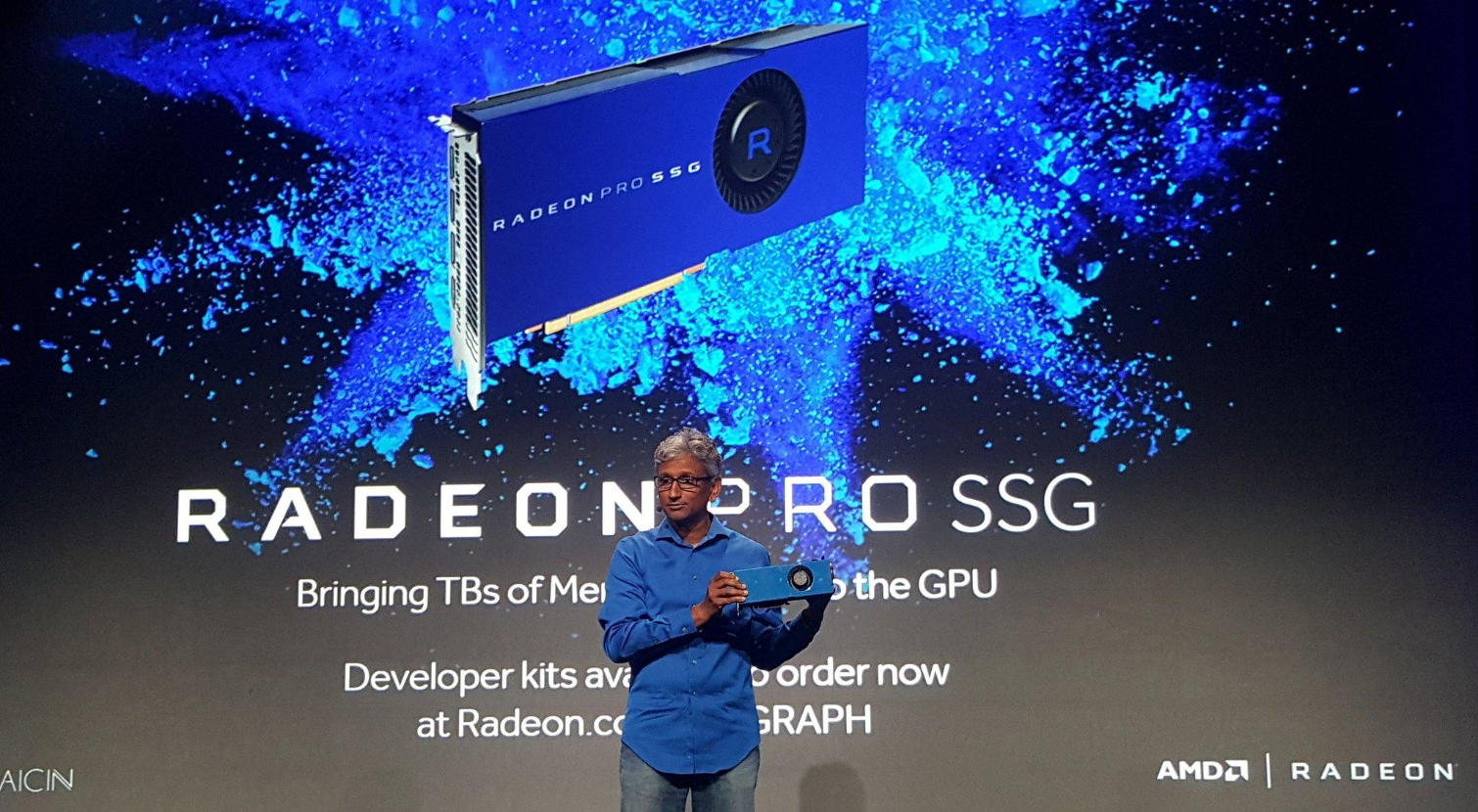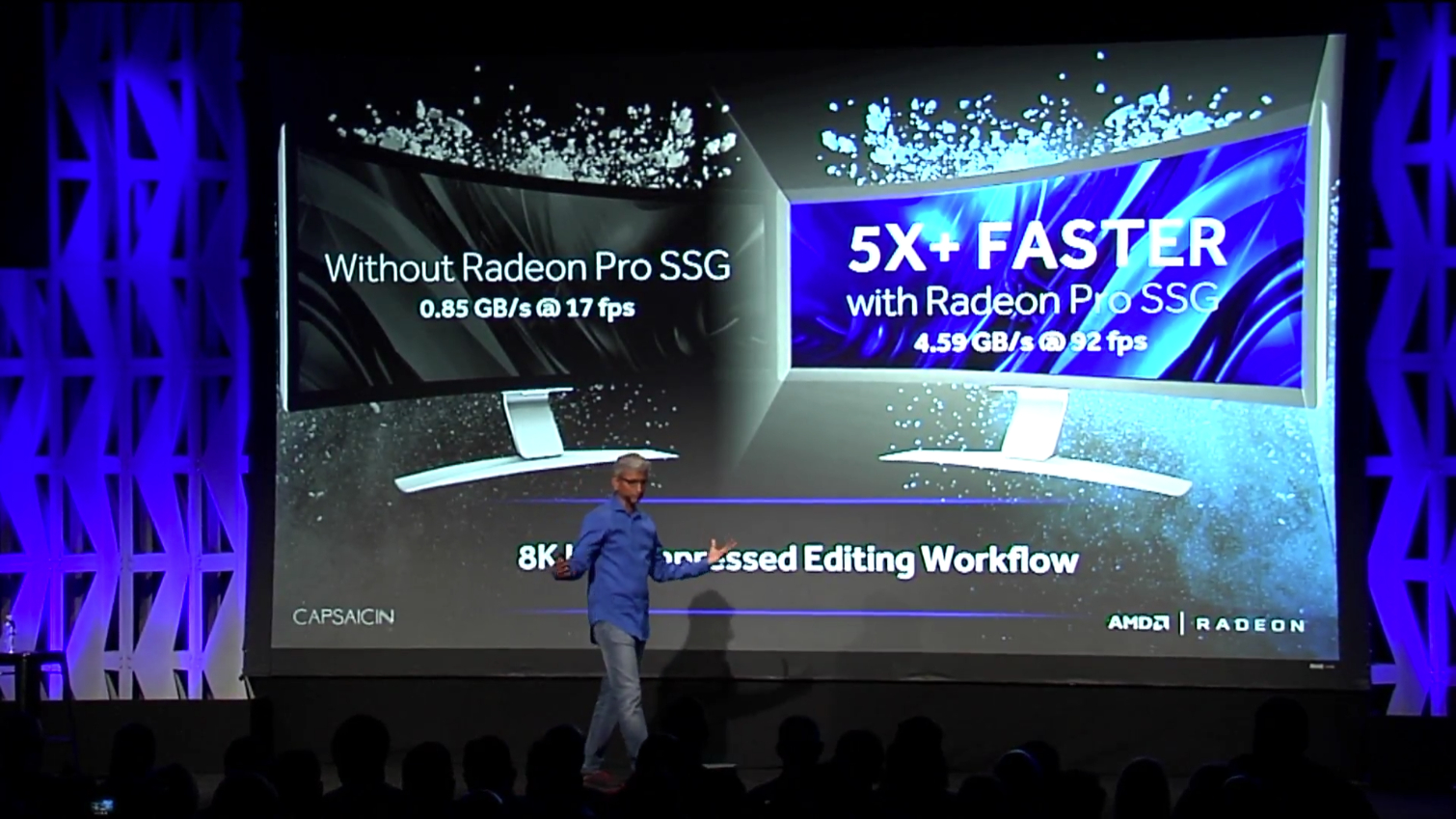AMD’s Radeon Pro SSG Features 1TB Of GPU Memory, Unheard-Of Rendering Capability
AMD’s Radeon Technology Group held its second Capsaicin event at Siggraph 2016 and revealed a new lineup of affordable workstation GPUs. The company also announced a Radeon that’s probably not so affordable but is far more unbelievable.
Raja Koduri, Radeon Technology Group’s Chief Architect and most senior executive, revealed an incredible new GPU called the Radeon Pro SSG. Koduri suggested that SSG will be a disruptive technology that will change Hollywood film production, and after seeing the company’s live demonstration, we’re inclined to believe that.
Koduri called Radeon Pro SSG technology a “fundamental change in workstation architecture.” The Radeon Pro SSG has an unprecedented 1TB of GPU memory. This massive frame buffer allows the Radeon Pro card to store and work with large data sets locally, rather than relying on transferring the data from system memory to the GPU. AMD said this results in 10x lower memory access latency.
The Radeon Pro SSG is designed to handle the type of workloads you’d find in a Hollywood film production. AMD set up two top level workstations on stage to demonstrate the rendering power of the Radeon PRO SSG live to the audience. Koduri said that each machine featured the fastest workstation components available on the market, including the most powerful CPUs and fastest SSD drives available. One of the workstations was equipped with a Radeon Pro SSG, and the other was not.
AMD showed the workstation without the Radeon Pro SSG rendering a raw 8K video live on stage. The PC was able to render the feed at approximately 17 frames per second, which is pretty respectable for 8K video. The company then switched to the machine with the Radeon Pro SSG inside, which was rendering the footage much quicker.
The Radeon Pro SSG was managing a steady 30Hz, which appeared buttery smooth. Koduri noted that the render was being limited to 30Hz, but it could go much faster. With the limitation disabled, the video render accelerated upwards of 90Hz. Sure, these demos always favor the product being shown, but assuming there are no games being played here, let that 90Hz sink in for a second.
The Radeon Pro SSG appears to be capable of faster-than-real-time rendering of 8K raw footage. The card was rendering 4.5GB/s at that pace. That amount of data processing will also let you scrub through hours 8K video footage in real-time. How’s that for a productivity boost?
Get Tom's Hardware's best news and in-depth reviews, straight to your inbox.
AMD said that the hardware is “very early,” but the company is accepting applications for Radeon Pro SSG dev kits immediately.
Kevin Carbotte is a contributing writer for Tom's Hardware who primarily covers VR and AR hardware. He has been writing for us for more than four years.
-
digitalgriffin Interesting. I bet amazon and Netflix will be getting these dev kits. Re scaling video on the fly is a real boon for both the server and client. It saves the host company on bandwidth nd improved the rendering quality on the client...win win for large libraries.Reply -
uglyduckling81 Reply18334481 said:1 TB M2 SSD , not Memory ...
This.
Also it's going to be $10k initially but it's sale is on a case by case basis. Only those deemed able to help it's development for a retail release will be sold one.
http://www.itworld.com/article/3100031/amd-packs-1tb-ssd-into-a-gpu-for-better-vr-and-gaming.html -
Beholder88 I'm curious to see how this thing is configured on the board level. Will there be any VRAM at all, or is the SSD acting AS the VRAM? Correct me if I'm wrong here, but HBM memory has a bandwidth of 256Mbps and SSDs can see more than twice that. Depending on the interface and controller being used this seems like a really good idea. Very obviously not for gaming, but the use cases could expand with advancement of the design. I like it, hopefully this give team red a bit of a boost.Reply -
Haravikk Neat, I guess I'll have to wait till it trickles down into my £200-300 graphics card price range though ;)Reply -
Kelgrin Maybe its just the fact that I do not deal with video editing or rendering, but the fact that the article talks about one machine rendering in FPS and the other in Hz confuses me. For me, it makes it difficult to compare the speed of the two machines since they appear to be using different measurements. I would assume the two (FPS and Hz) are not equal to each other. If they were, then I don't understand why there was a need to use two different terms to describe the same thing.Reply -
turkey3_scratch Reply18335891 said:Neat, I guess I'll have to wait till it trickles down into my £200-300 graphics card price range though ;)
It's not for gaming. -
kenjitamura They should have demonstrated a different use case because editing 8k video real-time is a non-issue with proxy clips. Should have shown it doing something like rendering a massive 3d model scene which this should also benefit really well.Reply

